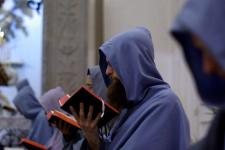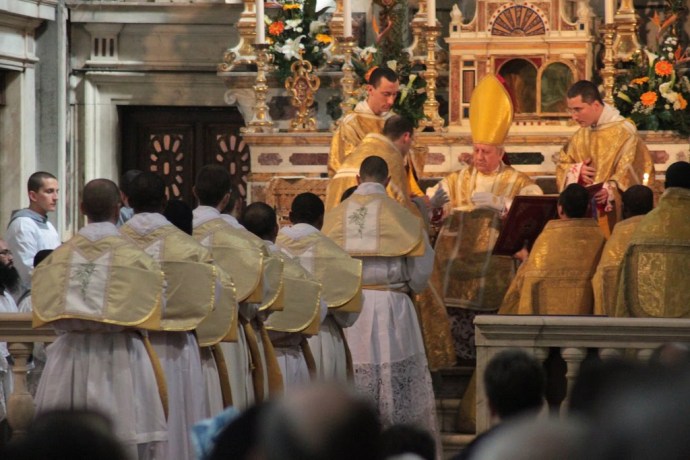Yesterday once again I asked Father Mauro Tranquilo to show me in the text of Vatican Council II, where does the Council contradict the dogma extra ecclesiam nulla salus.
 He opened a book in Italian with the documents and referred to Lumen Gentium 8, 'elements of sanctification and of truth are found outside of its visible structures.'
He opened a book in Italian with the documents and referred to Lumen Gentium 8, 'elements of sanctification and of truth are found outside of its visible structures.'
 He opened a book in Italian with the documents and referred to Lumen Gentium 8, 'elements of sanctification and of truth are found outside of its visible structures.'
He opened a book in Italian with the documents and referred to Lumen Gentium 8, 'elements of sanctification and of truth are found outside of its visible structures.'
I asked him to make the distinction between in theory and in practise, de jure and defacto, implicit and explicit otherwise there would be confusion in our discussion. He was not willing to do so.
If 'elements of sanctification and of truth found outside of its visible structure' are accepted only in principle, in faith, in theory these cases are not exceptions to the dogma extra ecclesiam nulla salus. If these cases are considered known defacto, in reality, personally on earth, then they are exceptions to the dogma extra ecclesiam nulla salus.
Philosophically, for something to be an exception it must be different and it must exist.It must exist in our reality, it must be visible to be an exception.
The dogma on exclusive salvation in the Catholic Church says all need to be visible members of the Church for salvation. Vatican Council II (Ad Gentes 7) says all need ' faith and baptism' for salvation.Where are the visible exceptions in 2014?
We do not know if there was a single case of the baptism of desire over the last 100 years. So how can it be an exception. We have not seen anyone saved in 2014 with 'elements of sanctification and truth' this year.Can we practically demarcate the visible structure outside the Church and decide who is saved and who is not this year?
These are all hypothetical cases.Hypothetical cases cannot contradict the de fide teaching on salvation.
LG 8 does not contradict AG 7 nor the dogma extra ecclesiam nulla salus.
If Fr.Mauro Tranquillo insists that it is a contradiction it would be saying that we can see ghosts, people now who are spirits. Salvation in Heaven is physically visible to us. This would be an irrational interpretation of Vatican Council II (LG 8).
I think the error is innocent. They just have not looked at the issue philosophically.They are using an absurd premise to create a non traditional theology. Invisible cases are assumed to be visible.
-Lionel Andrades
8. Christ, the one Mediator, established and continually sustains here on
earth His holy Church, the community of faith, hope and charity, as an entity
with visible delineation (9*) through which He communicated truth and grace to
all. But, the society structured with hierarchical organs and the Mystical Body
of Christ, are not to be considered as two realities, nor are the visible
assembly and the spiritual community, nor the earthly Church and the Church
enriched with heavenly things; rather they form one complex reality which
coalesces from a divine and a human element.(10*) For this reason, by no weak
analogy, it is compared to the mystery of the incarnate Word. As the assumed
nature inseparably united to Him, serves the divine Word as a living organ of
salvation, so, in a similar way, does the visible social structure of the Church
serve the Spirit of Christ, who vivifies it, in the building up of the body.(73)
(11*)
This is the one Church of Christ which in the Creed is professed as one,
holy, catholic and apostolic, (12*) which our Saviour, after His Resurrection,
commissioned Peter to shepherd,(74) and him and the other apostles to extend and
direct with authority,(75) which He erected for all ages as "the pillar and
mainstay of the truth".(76) This Church constituted and organized in the world
as a society, subsists in the Catholic Church, which is governed by the
successor of Peter and by the Bishops in communion with him,(13*) although many
elements of sanctification and of truth are found outside of its visible
structure. These elements, as gifts belonging to the Church of Christ, are
forces impelling toward catholic unity.
Just as Christ carried out the work of redemption in poverty and persecution,
so the Church is called to follow the same route that it might communicate the
fruits of salvation to men. Christ Jesus, "though He was by nature God . . .
emptied Himself, taking the nature of a slave",(77) and "being rich, became
poor"(78) for our sakes. Thus, the Church, although it needs human resources to
carry out its mission, is not set up to seek earthly glory, but to proclaim,
even by its own example, humility and self-sacrifice. Christ was sent by the
Father "to bring good news to the poor, to heal the contrite of heart",(79) "to
seek and to save what was lost".(80) Similarly, the Church encompasses with love
all who are afflicted with human suffering and in the poor and afflicted sees
the image of its poor and suffering Founder. It does all it can to relieve their
need and in them it strives to serve Christ. While Christ, holy, innocent and
undefiled(81) knew nothing of sin,(82) but came to expiate only the sins of the
people,(83) the Church, embracing in its bosom sinners, at the same time holy
and always in need of being purified, always follows the way of penance and
renewal. The Church, "like a stranger in a foreign land, presses forward amid
the persecutions of the world and the consolations of God"(14*), announcing the
cross and death of the Lord until He comes."(84) By the power of the risen Lord
it is given strength that it might, in patience and in love, overcome its
sorrows and its challenges, both within itself and from without, and that it
might reveal to the world, faithfully though darkly, the mystery of its Lord
until, in the end, it will be manifested in full light. -Lumen Gentium 8, Vatican Council II (Emphasis added)
![procession i[1][1]](http://veneremurcernui.files.wordpress.com/2014/01/procession-i11.jpg?w=225&h=168)




